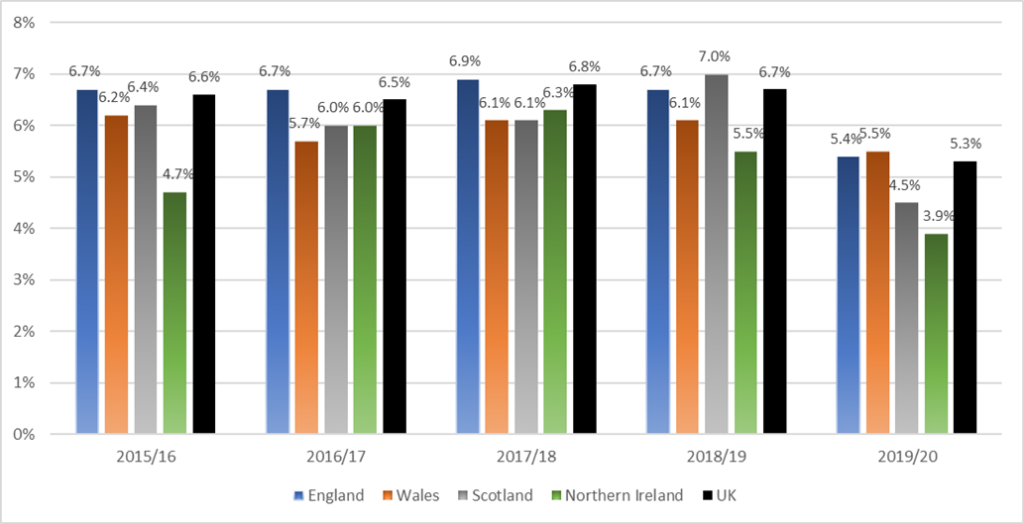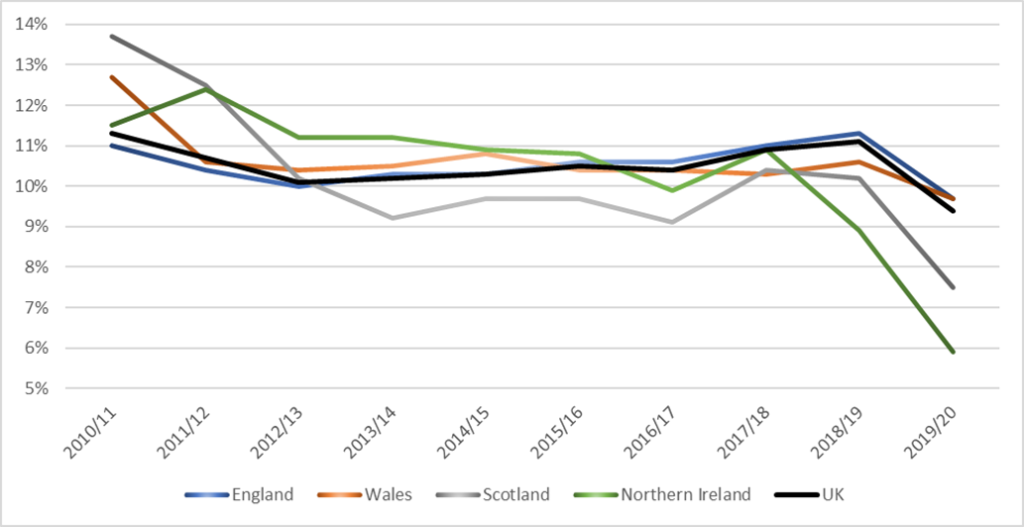
Dr Kostas Kollydas discusses the multifaceted reasons behind higher education dropouts, emphasising the need to confront ethnic discrepancies in academic achievement that result in involuntary withdrawal from studies.
Theoretical background
The concept of dropout rates refers to the fraction of students who, for whatever reasons, abandon their course before completion. The issue of student dropouts from the United Kingdom’s higher education institutions has gained political and societal attention, spurring policy adjustments over recent times. The financial and other implications of students discontinuing their studies cause significant concern in many countries, not just for the students and universities, but also for the broader society. This concern persists in the UK despite it maintaining satisfactory degree completion rates in comparison to other countries.
In the economics of education literature there are two traditional competing theories regarding the effect of (higher) education on labour market outcomes, namely the “human capital theory” and the “screening hypothesis”. The human capital theory, on the one hand, puts forth the idea that increased education uplifts an individual’s productivity and ability to socially integrate. This, in turn, amplifies the market value of their work. On the other hand, the filtering function of education presents a contrasting viewpoint, postulating that earnings variations in the job market do not merely reflect the productivity boost resulting from education. Instead, because of asymmetric information, employers see education as a signal of an applicant’s inherent talents and capabilities. This leads prospective employees to choose their level of education as a means to signal their potential to future employers.
Despite these differing viewpoints, research indicates a noticeable trend: individuals who secure a degree generally enjoy a wage premium post-university when compared to those who do not complete their studies. This holds true even when both groups have spent an equal number of years in education. This theory is known as the “sheepskin effect” in economic literature. Consequently, individuals who discontinue university education often find themselves in a less favourable position in the job market as compared to their counterparts who successfully graduate.
Measuring dropout rates
Reported dropout rates demonstrate significant fluctuations due to the varying definitions and datasets employed. Various entities such as central bodies, universities, and the academic literature frequently employ different methods to calculate student retention and withdrawal. For example, the official measure of non-continuation, as defined by the Higher Education Statistics Agency (HESA), is derived by monitoring the activity of UK-domiciled undergraduates during the academic year following their admission. This indicator does not take into account students who exit university shortly after beginning their studies (within 50 days). For part-time students, this observation period extends to two years post-enrolment.
Based on HESA’s indicator, the dropout rate of full-time young undergraduate students in the UK varied from 6.6% for those beginning their studies in the 2015/16 academic year to 5.3% for those starting in the 2019/20 academic year (see Figure A below). Some variations exist across the UK nations, with Northern Irish universities witnessing the lowest dropout rates during this timeframe. The dip in dropout rates for the 2019/20 academic year enrolments could be linked to the outbreak of the COVID-19 pandemic and the resulting economic downturn. These factors likely lowered the opportunity costs of higher education, thereby reducing the number of students exiting university for employment prospects. This trend might also be influenced by the “no detriment” policies implemented by numerous universities when confirming grades and results, leading to enhanced student learning and assessment experience in comparison to the pre-pandemic years.

In a similar vein, HESA projects the percentage of UK-based, full-time, first-degree students in the UK who neither earn a degree nor switch to a different institution. This decreased from 11.3% in the 2010/11 academic year to 10.1% in 2012/13. Subsequently, it demonstrated an upward trend, peaking at 11.1% in the 2018/19 academic year, before experiencing a decline to 9.4% in the subsequent year (see Figure B). The percentage of UK-domiciled, part-time, first-degree students who left higher education two years after enrolment was significantly higher, standing at approximately 29.5% in 2018/19. This represents a decrease of 1.5 percentage points compared to the previous year.
A. Proportion of UK-domiciled, full-time, first-degree students (aged 20 or less at entry) not continuing in higher education after their first year, by university location and academic year of entry (2015/16-2019/20)

B. Projected non-completion rates for UK-domiciled, full-time, first-degree starters, by university location and academic year of entry (2010/11-2019/20)

Determinants for student dropout
Tinto’s groundbreaking work in 1975 in the US proposed that non-completion likelihood hinges on a multidimensional process shaping the extent of a student’s integration into the university environment. His path analysis model, which incorporates a range of personal, social, academic, and organisational factors that affect student retention in higher education, has served as the theoretical foundation for subsequent empirical studies. A closer look at the factors affecting student dropout reveals that student withdrawal is typically the outcome of a lengthy decision-making process and a complex interplay of numerous determinants. These include individual characteristics (such as gender, age, geographic origin, parental and migration background, prior educational performance, study organisation, and psychological characteristics), institutional-level factors (e.g., type of university, field of study, study conditions and environment, teaching quality), and national system-level factors (such as a country’s education system and financing policy).
Extensive research has attempted to quantify the impact of key characteristics on the probability of non-completion in UK higher education. Yorke and Longden’s 2008 study, for instance, utilised principal component analysis to pinpoint the primary reasons driving student departure. Their analysis identified seven major influences: an unsatisfactory learning experience, inappropriate subject choice, the university’s location and environment, difficulties in fulfilling academic requirements, dissatisfaction with provided resources, financial/employment hardships, and challenges with social integration. In other studies, family background has emerged as a potent predictor of enrolment loss, as it is closely linked with students’ financial capabilities, readiness for higher education success, and career aspirations post-university. Specifically, university students who come from highly deprived backgrounds show a considerably higher tendency to drop out when compared to their counterparts from the highest socio-economic group, even when factors such as demographic traits, educational achievement, the type of university, and the subject of study are taken into account.
The role of ethnicity in students’ dropout behaviour
Recent data indicate that the dropout rates for certain ethnic minorities surpass those of their White peers. For example, in the 2019/20 academic year in England, the proportion of Black full-time undergraduate students who did not continue their courses after 12 months was 12.6% – a figure 4.6 percentage points greater than their White counterparts.
Yet, the factors contributing to these ethnic differences in dropout probabilities have largely been overlooked in academic and grey literature. The existing body of research has fallen short in differentiating between the types of dropouts – whether they are forced due to academic failure or voluntary due to personal, financial or other circumstances – especially in relation to the disparities linked to ethnicity. This gap in understanding, which was a major driver for my PhD research at the University of Bath, could have serious implications on policy formation, making it challenging to identify and address the unique needs of different ethnic student groups.

In my study, I utilised individual-level data from HESA spanning five academic years (2010/11-2014/15) and concentrated on students who resided in the UK prior to embarking on a first-degree course. The aim was to mitigate the potentially distorting effects of English proficiency and other unobserved (unmeasured) traits that vary between international and UK-based students, which could disproportionately affect the likelihood of degree completion.
The regression analysis results showed that ethnic minority groups, in general, have a higher propensity than White students to leave university due to academic underperformance, termed as “involuntary” dropout. Alarmingly, Black African students face almost double the risk of academic failure (7.1%) compared to their White peers (3.8%). When taking into account interaction effects, the gap in academic failure between ethnicities is more noticeable among men than women across most ethnic minority groups, although these disparities are less pronounced at Russell Group universities. The socio-economic background does not considerably influence the ethnic differences in involuntary dropout rates. On the other hand, White undergraduates tend to voluntarily leave university at a higher rate (for personal reasons or to enter the job market, for example) than all ethnic minority groups.
Possible policy interventions to reduce ethnic inequalities in academic failure
In my PhD thesis, I also discussed potential measures to mitigate the aforementioned ethnic disparities. Universities should aim to cultivate ethnically inclusive environments by enhancing support services, such as mentoring programs. Instead of merely addressing perceived issues with ethnic minority students, the focus should be on fostering a transformation in “campus culture”, thus strengthening students’ sense of belonging at their institution. Introducing learning analytics, while mindful of ethical considerations, could help track students’ academic journey, potentially elevating student retention and enhancing teaching and learning processes. In addition, making university attainment-gap data accessible to academic staff and adjusting curriculum content might also contribute to reducing ethnic disparities in achievement and pinpointing students who may benefit from extra academic aid. Crucially, students with considerably lower entry profiles should be provided with tailored study skills training sessions specific to their course requirements. This recommendation is particularly applicable to Black, Pakistani, and Bangladeshi undergraduates, who, on average, have a lower level of prior educational attainment than other ethnic groups.

Incentive-driven funding models, where institutions’ funding is tied to student retention, have been successfully employed in other countries, encouraging universities to facilitate academic success. Such funding models could be expanded to target the eradication of ethnic inequalities in dropout rates. Given the higher likelihood of certain ethnic minorities (particularly Black students) encountering financial hardship and subsequently dropping out of higher education, a commitment to financial support as an additional retention strategy is also important. This support could be implemented as funding associated with academic progress and additional university bursaries for undergraduates from low-income families.
Finally, devising effective information campaigns in schools about university and course options could help align prospective students’ academic abilities with the demands of each university or study subject. Consequently, such policy measures could reduce dropout rates arising from unsuitable subject choices.
Some of the interventions mentioned above become even more significant and timely in view of the current cost-of-living crisis. This crisis has introduced extra financial burdens to the university experiences of students (particularly those from lower socio-economic backgrounds, including certain ethnic minority groups), thereby prompting them to work while studying or to contemplate withdrawing from higher education.
This blog was written by Dr Kostas Kollydas, Research Fellow at City-REDI / WMREDI, University of Birmingham.
Disclaimer:
The views expressed in this analysis post are those of the authors and not necessarily those of City-REDI / WMREDI or the University of Birmingham.
